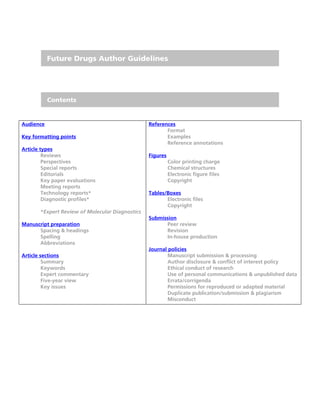This document provides guidelines for authors submitting articles to Future Drugs journals. It outlines the various article types including reviews, perspectives, special reports, editorials, key paper evaluations, meeting reports, and technology reports. It specifies formatting requirements such as word counts, required sections, references, figures/tables, and submission details. The intended audience is clinicians, scientists, and healthcare professionals.

![Audience
The audience for the Expert Review series consists of clinicians, R&D scientists, regulatory and
marketing professionals in the pharmaceutical industry and decision-makers in healthcare provision.
Authors should bear in mind the multidisciplinary status of the readership when writing the article.
Expert Review articles have been engineered specifically for the online environment. The structure is
designed to draw the reader’s attention directly to the information they require.
Key formatting points
Please ensure your paper concurs with the following article format:
Title: concise, not more than 120 characters.
Author(s) names & affiliations: including full name, address, phone & fax numbers and e-mail.
Abstract/Summary: approximately 120 words. No references should be cited in the abstract.
Keywords: approximately 5–10 keywords for the review.
Body of the article: article content under relevant headings and subheadings.
Expert commentary: the author’s expert view on the current status of the field under discussion.
Five-year view: a speculative viewpoint on how the field will evolve in 5 years time.
Key issues: 8–10 bullet points summarizing the review.
References:
For full details on formatting see References section above.
• Should be numerically listed in the reference section in the order that they occur in the text.
• Should appear as a number i.e., [1,2] in the text.
• If websites or patents are included, please use a separate numbering system for them, i.e.,
start numbering website references at [101] and patents at [201] to allow the reader to
distinguish between websites/patents and primary literature references both in the text and
in the bibliography.
• Any references that are cited in figures/tables/boxes that do not appear in the text should be
listed at the end of the reference list in the order they occur.
• Quote first six authors’ names. If there are more than six, then quote first three et al.
• The Future Drugs Endnote style can be downloaded from our website at:
www.future-drugs.com/page/authors.jsp
Reference annotations: please highlight 6–8 references that are of particular significance to the
subject under review as “* of interest” or “** of considerable interest” and provide a brief (1–2 line)
synopsis.
Figures/Tables/Boxes: Summary figures/tables/boxes are very useful, and we encourage their use in
reviews/perspectives/special reports. The author should include illustrations and tables to condense
and illustrate the information they wish to convey. Commentary that augments an article and could](https://image.slidesharecdn.com/authorguidelines1-120117122910-phpapp02/85/Author-guidelines1-2-320.jpg)




![Not more than 150 words, this should not be an abstract but merely a scene-setting summary
outlining the article scope and briefly putting it in context. The role of the summary is to draw in the
interested casual browser.
Keywords
Up to 10 keywords (including therapeutic area, mechanism(s) of action etc.) plus names of drugs and
compounds mentioned in the text.
Expert commentary
The authors’ recommendations regarding existing and new clinical strategies and drug products,
introducing new therapeutic/diagnostic paradigms and discussing their likely impact on current
management of disease.
Five-year view
Authors are challenged to include a speculative viewpoint on how the field will have evolved 5 years
from the point at which the review was written.
Key issues
An executive summary of the authors’ main points (bulleted) is very useful for time-constrained
readers requiring a rapidly accessible overview.
Example:
References
Authors should focus on recent papers and papers older than 5 years should not be included except
for an over-riding purpose.
References should be denoted numerically and in sequence in the text, using Arabic numerals placed
in square brackets, i.e., [12].
If websites or patents are included, please use a separate numbering system for them, i.e., start
numbering website references at [101] and patents at [201] to allow the reader to distinguish
between websites/patents and primary literature references both in the text and in the bibliography.](https://image.slidesharecdn.com/authorguidelines1-120117122910-phpapp02/85/Author-guidelines1-7-320.jpg)








